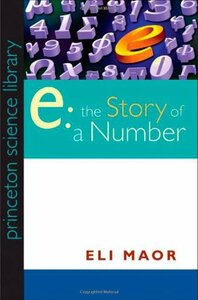Take a photo of a barcode or cover
informative
slow-paced
challenging
informative
medium-paced
Reading this book had me wondering about the mystical properties of numbers, whether there was some elemental truth I could discover. Overall, the book was an enjoyable and illuminating examination of e, and a solid retelling of e's importance in the development of trigonometry.
This book was a goodbye gift from a job I had two years ago, so it's good that I finally finished it. If you find the premise of this book enticing, you'll probably enjoy it. There's a good mix of math (fairly basic to anyone that majored in math) and math history, so it stays engaging throughout.
I may not be a mathematician, but I always loved math in school, and I like reading about math and science (I loved Infinite Powers, for example), so I was excited to read this book. Maor states in the prologue that his goal is "to tell the story of e on a level accessible to readers with only a modest background in mathematics" and promises to minimize the use of mathematical formulas in the text. Given that, I anticipated this book would be similar to Strogatz's in approach, and would be a fascinating look at the history of a number.
I think, however, that Maor and I have a different definition of "modest background." I found the book to be highly technical, and while the longer derivations might have been confined to the appendices, the text was still full of mathematical formulae. If I went verrrrry slowly and tried to pull out all of my old memories from my high school and college calculus classes, I could sort of follow him, but I certainly wouldn't call it accessible.
I'm guessing that math majors and others in fields that use complex math on a daily basis would find the book interesting. I just wasn't his target audience, no matter how he framed his intentions in the prologue.
I think, however, that Maor and I have a different definition of "modest background." I found the book to be highly technical, and while the longer derivations might have been confined to the appendices, the text was still full of mathematical formulae. If I went verrrrry slowly and tried to pull out all of my old memories from my high school and college calculus classes, I could sort of follow him, but I certainly wouldn't call it accessible.
I'm guessing that math majors and others in fields that use complex math on a daily basis would find the book interesting. I just wasn't his target audience, no matter how he framed his intentions in the prologue.
Rubbish, but damn, the history of math is more interesting than even he seems to know.
Great history book of mathematics which explains also the mathematical concepts themselves
Despite being described as accesible to readers with 'only a modest background in mathematics', the equations depicted are fairly complicated. Whether because the workings of logarithms with a slide rule is now obsolete, or because I haven't studied math for several years, I found the proofs and explanations difficult to get my head round.
However all this was interspersed with chapters on the major figures in mathematical history, and a sequential description of it's advancement, which was interesting. Some parts were even amusing and I would recommend this book to anyone interested in mathematics.
However all this was interspersed with chapters on the major figures in mathematical history, and a sequential description of it's advancement, which was interesting. Some parts were even amusing and I would recommend this book to anyone interested in mathematics.

